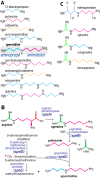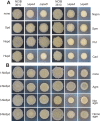Spermidine promotes Bacillus subtilis biofilm formation by activating expression of the matrix regulator slrR
- PMID: 28546427
- PMCID: PMC5519356
- DOI: 10.1074/jbc.M117.789644
Spermidine promotes Bacillus subtilis biofilm formation by activating expression of the matrix regulator slrR
Abstract
Ubiquitous polyamine spermidine is not required for normal planktonic growth of Bacillus subtilis but is essential for robust biofilm formation. However, the structural features of spermidine required for B. subtilis biofilm formation are unknown and so are the molecular mechanisms of spermidine-stimulated biofilm development. We report here that in a spermidine-deficient B. subtilis mutant, the structural analogue norspermidine, but not homospermidine, restored biofilm formation. Intracellular biosynthesis of another spermidine analogue, aminopropylcadaverine, from exogenously supplied homoagmatine also restored biofilm formation. The differential ability of C-methylated spermidine analogues to functionally replace spermidine in biofilm formation indicated that the aminopropyl moiety of spermidine is more sensitive to C-methylation, which it is essential for biofilm formation, but that the length and symmetry of the molecule is not critical. Transcriptomic analysis of a spermidine-depleted B. subtilis speD mutant uncovered a nitrogen-, methionine-, and S-adenosylmethionine-sufficiency response, resulting in repression of gene expression related to purine catabolism, methionine and S-adenosylmethionine biosynthesis and methionine salvage, and signs of altered membrane status. Consistent with the spermidine requirement in biofilm formation, single-cell analysis of this mutant indicated reduced expression of the operons for production of the exopolysaccharide and TasA protein biofilm matrix components and SinR antagonist slrR Deletion of sinR or ectopic expression of slrR in the spermidine-deficient ΔspeD background restored biofilm formation, indicating that spermidine is required for expression of the biofilm regulator slrR Our results indicate that spermidine functions in biofilm development by activating transcription of the biofilm matrix exopolysaccharide and TasA operons through the regulator slrR.
Keywords: Bacillus subtilis; agmatine; aminopropyl; bacteria; biofilm; exopolysaccharide; polyamine; slrR; spermidine; transcriptomics.
© 2017 by The American Society for Biochemistry and Molecular Biology, Inc.
Conflict of interest statement
The authors declare that they have no conflicts of interest with the contents of this article
Figures





Similar articles
-
Functional analysis of the protein Veg, which stimulates biofilm formation in Bacillus subtilis.J Bacteriol. 2013 Apr;195(8):1697-705. doi: 10.1128/JB.02201-12. Epub 2013 Feb 1. J Bacteriol. 2013. PMID: 23378512 Free PMC article.
-
Inactivation of cysL Inhibits Biofilm Formation by Activating the Disulfide Stress Regulator Spx in Bacillus subtilis.J Bacteriol. 2019 Mar 26;201(8):e00712-18. doi: 10.1128/JB.00712-18. Print 2019 Apr 15. J Bacteriol. 2019. PMID: 30718304 Free PMC article.
-
A novel factor controlling bistability in Bacillus subtilis: the YmdB protein affects flagellin expression and biofilm formation.J Bacteriol. 2011 Nov;193(21):5997-6007. doi: 10.1128/JB.05360-11. Epub 2011 Aug 19. J Bacteriol. 2011. PMID: 21856853 Free PMC article.
-
The Biofilm Regulatory Network from Bacillus subtilis: A Structure-Function Analysis.J Mol Biol. 2023 Feb 1;435(3):167923. doi: 10.1016/j.jmb.2022.167923. Epub 2022 Dec 16. J Mol Biol. 2023. PMID: 36535428 Review.
-
Bacillus subtilis biofilm formation and social interactions.Nat Rev Microbiol. 2021 Sep;19(9):600-614. doi: 10.1038/s41579-021-00540-9. Epub 2021 Apr 6. Nat Rev Microbiol. 2021. PMID: 33824496 Review.
Cited by
-
In Silico Safety Assessment of Bacillus Isolated from Polish Bee Pollen and Bee Bread as Novel Probiotic Candidates.Int J Mol Sci. 2024 Jan 4;25(1):666. doi: 10.3390/ijms25010666. Int J Mol Sci. 2024. PMID: 38203838 Free PMC article.
-
Developing natural products as potential anti-biofilm agents.Chin Med. 2019 Mar 20;14:11. doi: 10.1186/s13020-019-0232-2. eCollection 2019. Chin Med. 2019. PMID: 30936939 Free PMC article. Review.
-
Use of Cell Envelope Targeting Antibiotics and Antimicrobial Agents as a Powerful Tool to Select for Lactic Acid Bacteria Strains With Improved Texturizing Ability in Milk Fermentations.Front Bioeng Biotechnol. 2021 Jan 13;8:623700. doi: 10.3389/fbioe.2020.623700. eCollection 2020. Front Bioeng Biotechnol. 2021. PMID: 33520973 Free PMC article.
-
A new coumarin compound DCH combats methicillin-resistant Staphylococcus aureus biofilm by targeting arginine repressor.Sci Adv. 2020 Jul 22;6(30):eaay9597. doi: 10.1126/sciadv.aay9597. eCollection 2020 Jul. Sci Adv. 2020. PMID: 32832655 Free PMC article.
-
The Acinetobacter baumannii disinfectant resistance protein, AmvA, is a spermidine and spermine efflux pump.Commun Biol. 2021 Sep 22;4(1):1114. doi: 10.1038/s42003-021-02629-6. Commun Biol. 2021. PMID: 34552198 Free PMC article.
References
-
- Michael A. J. (2016) Biosynthesis of polyamines and polyamine-containing molecules. Biochem. J. 473, 2315–2329 - PubMed
Publication types
MeSH terms
Substances
Grants and funding
LinkOut - more resources
Full Text Sources
Other Literature Sources
Molecular Biology Databases

